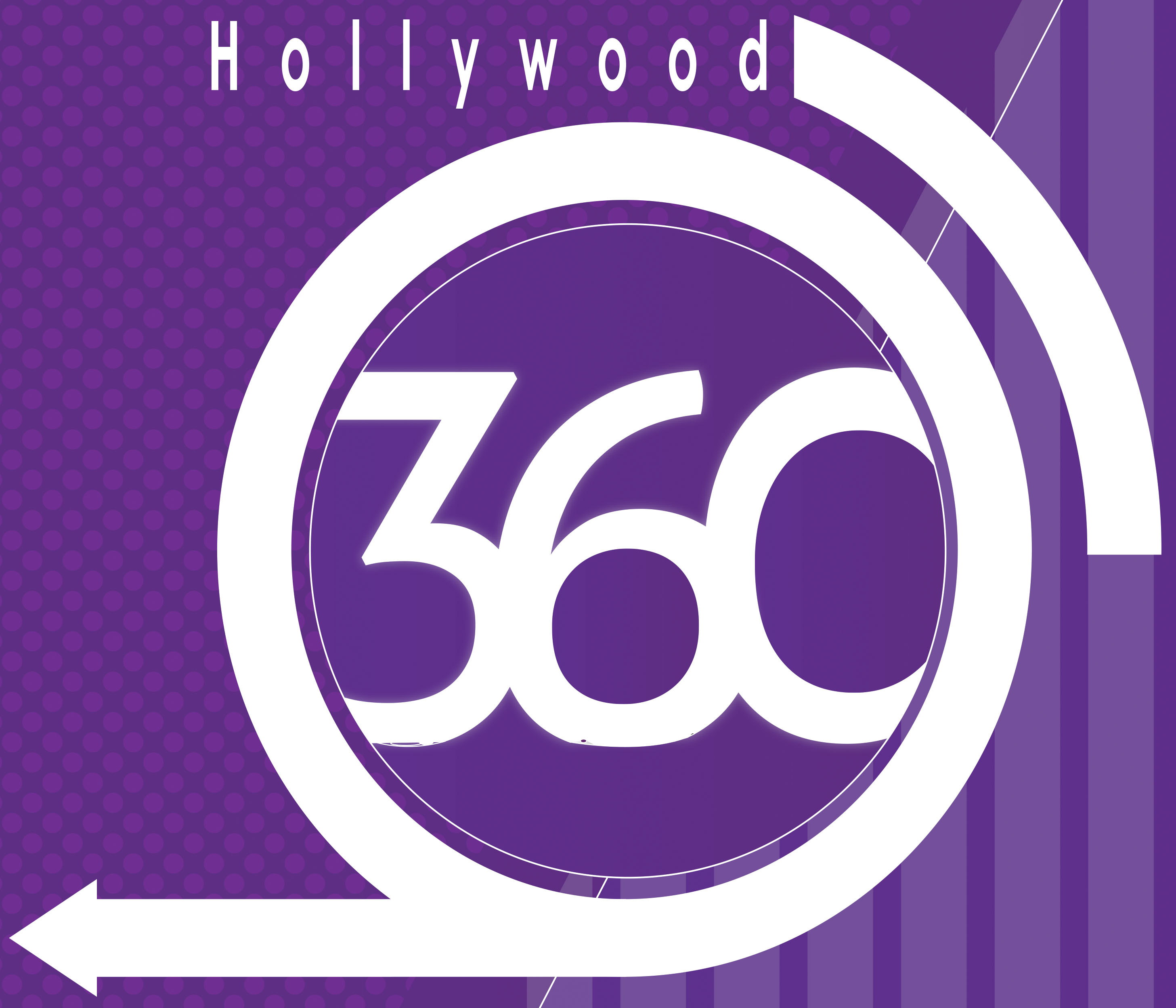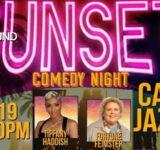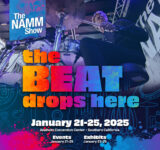A couple of days have passed since the third annual Digital Entertainment World (DEW) Expo, a joint venture between IDG World Expo and Digital Media Wire, which took place Feb 9 – 11, 2016, at the Hyatt Regency Century Plaza, Los Angeles, Ca.
By: Fredwill Hernandez
Many [like me] are probably still thinking, processing, and trying to figure how they can apply and use some of the valuable information they acquired, including many new contacts from the who’s who of digital entertainment.
What made the three day expo interesting, fun, and worth attending was the fact it catered to all with tracks in Video/TV/Movies, Brands/Advertising, Games/Interactive, Music/Rights, and Innovation [Stage], including fireside chats, among other valuable, informative, and excellent networking opportunities.
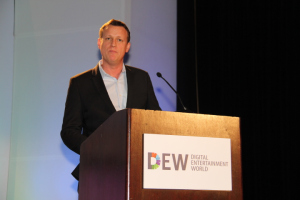
“A little bit about this years’ program. This year is about the future, our theme is the future of, over the next three days we are going to cover the future of a lot of different topics, in fact about 100 different topics. Some of those topics included OTT or over the top, innovation, esports, millennial marketing, content marketing, artist/fan experiences, virtual reality, and start-ups. The program is really designed for us to be looking into the future,” eloquently expressed Ned Sherman, CEO, Digital Media Wire, co-founder DEW Expo, during his welcoming remarks after thanking and expressing gratitude and reiterating the importance of sponsors, media partners, and DEW’s executive board. “We believe that fostering a dynamic start-up community is essential to industry growth and this end, we partnered with IDG Ventures USA, Baker and Hostetler [Law], and Rackspace Startups, to offer 12 innovative start-ups opportunity to compete on stage for DEW start-up of the year [award]. …thank you for being part of the DEW community, prepare yourself to be challenged, excited, and inspired, and I hope you enjoy the next three days.”
On Tues. – Feb 9, Nassem Seyani, VP of Business Strategy, Huge LA, kicked things off with a brief and informative presentation on Millenials.
“How do we understand millennial today ?, is a personality we are leaning more about each day. At the top, they are totally fearless, there is something about how they think and the way they been raised that makes them not constrained by limitations or rules, they often disregard instructions. They are going to find their own way and chart their own rules, there is a passion around doing that, resilient in their pursue of figuring out a system and really making that system theirs,” passionately explained Seyani. “There are no limits, In reality there is nothing they cannot accomplish. The kind of tool kit they are growing up with is different than any of us grew up with, and they are growing up in digital and not transitioning from analog to digital like some of us had to do, their behavior have transformed their most basic assumptions. Previously same-sex marriages were not a thing [they were nothing] we talked about, now it’s been legalized, so the world they are growing up in has progressed in a way that is different than any of us grew up in. The DVD used to be standard, now Youtube is their source for video content. Instant messaging used to be a tool that some people used and now Snapchat is how they communicate, it’s a completely different paradigm for how they are interacting with friends, their peers, with their parents, with their teachers. They’ve gone from [something I would call] being tech savvy to tech innate, and that is changing what it requires us as marketers to be able to do when we interact with them.”
During her presentation Seyani, painted a picture of how Millenials think, act, and most importantly, about their patterns and trends.
“What happens, what’s next, how do we reach this generation of crazy people [but in a real good way]?, the four marketing imperatives are first – get past the basics; second- know your personality; third- relish the participation; and forth – embrace or harness [don’t fear] the opportunity,” added Seyani. “I would argue [ultimately] that marketing to millennials is going to become the baseline of how we are going to market to anybody.”
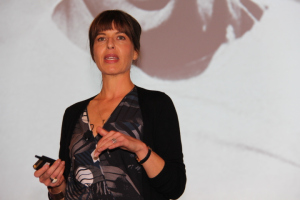
Another exciting and informative presentation Tues. [Feb 9] morning was by Margaret Czeisler, Chief Strategy Officer, Wildness, who explained research findings and the importance of Generation Z [ages from 12 to 24 studied], who are changing the way all people communicate and behave.
“This generation [Z] is already rewriting the rules, they are transcending the borders of gender, of culture, of race, and they are embracing differences in a way that is unseen in the past,” eloquently expressed Czeisler. “The defining characteristics of this generation is not just the internet or technology, it is those things but it is the relationship to culture, and they just don’t consume culture because they make it and they create it. This is the generation of culture creators, they are weaving together media, commerce, entertainment, technology into a power house of influence and they are already changing business and commerce. … Every single minute on the internet 500 hours of videos are uploaded and share to Youtube, and over half a million [528,000 roughly] photos are uploaded on to Snapchat, largely of which is being created by this generation, by Gen Z. 27 percent from our study are creating and sharing an original video on a weekly basis. When we compared up all the adults, probably many of you in this room, only 26 percent of the entire adult population had ever shared an original video, this guys do that on a weekly basis. While they embrace this new visual language that is incredibly sophisticated through emojis, and photos, and videos. They are able to communicate enormous amount of information in poetry.”
During her presentation Czeisler, also discussed how they kept telling us [her] again and again that being weird is being cool and how being unique was incredibly important [to them]. Part of the importance of being unique was being true to themselves and how real life experiences still rule for them, how they really value what is authentic and what is human.
Among other things Czeisler, learned during the study [interviews] conducted was how [now] it is the opportunity for brands is to be more real, to experiment, to allow [themselves] yourself the failure because if you are honest, unpolished, and real, they will forgive you for your mistakes. It is important [also] to collaborate, to invite them in, to listen to them, because if you don’t – they are going to built their own products. They told us with surprising maturity the importance of failure, for 91 percent feel failure is an important part of life and the process.
“This is the generation with the shortest attention span in history and you can pack a lot of meaning in 140 characters. The opportunity for brands here is to challenge teens to create content and experiences with new formats that are as powerful as poetry,” also added Czeisler. “They do want to hear from brands, and while they will do anything to avoid commercials, they actually find most appealing branded, and sponsor content for brands. They want to hear from you in a way that is relevant, in a way it has a beat and a pace to it.”

Another interesting panel also held Tues. – Feb 9, which gave a View From The Top perspective, moderated by Natalie Jarvey, Staff Writer, Digital Media, The Hollywood Reporter, with panelists that also included Oliver Delfosse, COO, Stylehaul, and Jennifer Prince, Sr. Dir. of Media & Entertainment, Twitter, was The Future of Digital Media Content Market.
During this panel discussion opinions varied as to what works [for each], how they do business, what is done about content volume, cutting through and getting noticed.
“Because sight, sound, and motion is near and dear to both, we are not just focus on being a real time social platform with that real direct connection to culture, but also a video platform itself. We are excited about the possibilities of more digital story telling on Twitter, bringing the best of the best with brands, and marketers, consumers, and content creators,” explained Prince. “Twitter, has done a good job of innovating and investing, so we just don’t have Twitter as a platform, but we have Vine, we also have Pariscope, and Niche, a content creator network of about 25,000 creators. So when you think about how we’re working with brands and marketers, and ad agencies is all about bringing a holistic solution. So like Todd is mentioning, coming to one team of people to be able to educate with best practices and how to tackle each platform because they are very different. I’m sure a few of you would agree that creating a 6 second Vine is very different to a 2 minute 20 second trailer, so it’s about thinking about long form, short form and everything in- between and that’s what we try to do taking the friction away from making it so complex.”
Stylehaul’s Delfosse, stressed the importance of listening and taking cues from the actual content creators [he works with] who he feels are considered experts and the most sophisticated researchers since their success depends on a very real conversation with their audience. They talk to other content creators who know the different platforms, know what works best, and know when to migrate [or move] to a new platform.
The expo did not only provide insight from top company exec’s, but also from social media stars.
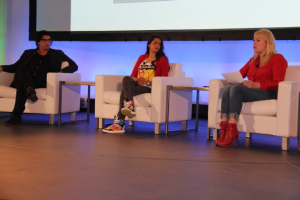
“The best thing that has come from traditional media’s refusal to allow females, LGBT folks and women of color to sit at the table, is that we have gone out and have sought alternative ways to be heard and share our stories. Digital media is the home for everyone who has been excluded and [boy] did Hollywood under estimate the power of those excluded have gained,” expressed Amanda de Cadanet, host, The Conversation, before introducing Lilly “Superwoman” Singh, Youtuber/Actress, who she would interview during the day’s last Keynote: Straight Outta Youtube.
Singh, would point out that in social media, Youtube specifically, there are no rules, it is exciting, challenging, awesome, super unconventional, but making up the rules as we go can also be scary, who also revealed the loyalty that exist between her and her 7 million plus [subscribers] Youtube community.
“To fans I am just like them, I can reveal how I feel about my face, about having a bad hair day, I am unapologetic myself, and I feel like it is not just about me, my fans engage and also let me know what they think, that lets me [us] feel that we built this together,” explained Singh, who is releasing her first featured film [Feb.10] titled Welcome to Unicorn Island, Executive Produced by Nick Shore, Chief Creative Strategist, Austronauts Wanted, and has a lifetime supply of Skittles candy, a brand she loves and passionately endorses. “I get approached a lot about product endorsement, so from time-to-time, I have to say “no”, everything I do is organic, real and I have to believe in the product and have some connection to the brand since I’m in this for the long run, not just to get a quick pay check.”
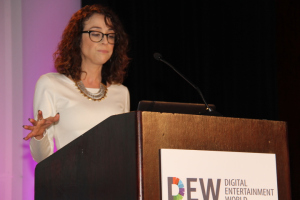
On Wed. – Feb. 10, Shira Lazar, co-founder/host/ep, What’s Trending, welcomed everybody for DEW Expo’s day two and briefly among other things, went over mobile marketing projections.
“I am very excited to see today’s presentations and fireside chats but I want to take a moment to congratulation you for being on the ground floor of Digital Entertainment this morning, I know none of you are used to having your egos shucked, but this place is only going to get more prominent, considering companies are expected to spend 100 billion dollars on mobile advertising this year [that is crazy], let me give you interesting numbers, it was 20 billion just three years ago, and it will be close to 200 billion by 2019,” explained Lazar. “When I see an interesting platform, I look for [ask] is there a community building here, is there creativity in terms of new and innovative ways to connect, engage and tell stories, that curiosity is what keeps us looking ahead – me, what’s trending, my team. I challenge each of you whether you are at a small, or big company, or an independent to do the same. Get out there, get in the trenches, don’t just read newsletters, reports, or go to conferences, although thank you DEW for hosting us today. Go to where people are using these platforms and tools, ask questions, be curious. We are not at a place anymore where if it ain’t broke, don’t fix it. I encourage all of you to keep fixing, tweaking and experimenting, jump right in no matter what. Go on snapchat even if you think you are going to be oldest on this one, because you don’t know the effect it will have on your business or your brand. It might be awkward at first [trust me], it might make you feel really old and weird but I will bet you will learn something and discover something you didn’t realize about yourself, your viewer, consumer, and you will sound super legit to the young people on your team or your kids. The opportunities for real time engagement are raw and real.”
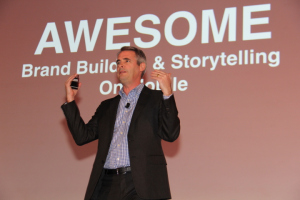
After day two welcoming remarks by Lazar, there were a couple of interesting presentations regarding The Future of Brands and Advertising, that included one by Mike McCue, CEO, Flipboard, who gave tips on Brand Building with Storytelling.
“People check their cell phones at least 150 times a day. The trick or challenge is how do you tell a story to a distracted audience ? One, be there during their most inspirational moments; two, target interest, not audiences; three, show them something beautiful; and fourth, curate those stories in a native way that feels genuine, that is fast, and looks good on a mobile device,” explained McCue, during his brief 8 minute presentation.
Another great presentation which touched on the importance of embracing Virtual Reality [VR] and Augmented Reality [AR] now, was made by Thom Gruhler, Corp. VP & CMO-Apps & Services, Microsoft.
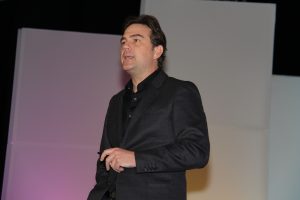
It’s important to get in now, my fear and challenge to you is that you’ll be left behind. My evidence to this is that, unlike other media the rate of innovation for AR and VR will actually go much faster than any that we’ve seen before with respect to how brands and media live in the world. Here’s my push to you, if you don’t get in now and begin building experiences for your brand and your content for how we are in AR and VR and all the innovation that will come around it, I think you will be missing the opportunity to stay ahead of the competition,” Gruhler emphasized. “This isn’t fundamentally how to create gadgetry around 3D video or some niche or passing fad around how video will be experienced around the world. This is fundamentally a different way you will interact with information. If you’re not developing the capabilities internally or with your agency then you will be left behind, this is not about new ways of doing 360 campaigns, you got to create specific experiences that are built to take advantage of this technology.”
Other advice Gruehl, gave was to start small with specific investments that you know you can make as a way to understand how these experiences and your content can come together.
“Don’t think of this as a 360 notion, don’t take a campaign concept and extend it into VR and AR, you’ll be sorry. Frankly, develop content that is unique for this platform because it will work back the other way to inform how your 360 content is less real, less rich, less 3D, less emotional, it will influence all that in a unique way. You can actually start with VR and AR, so think of it as its own channel and build content that is specific to the channel,” reiterated Gruehl. “The last thing I will tell you, while there are a lot of great agencies out there, develop this technology internally.”
An interesting music/rights fireside chat held Wed. – Feb. 10, moderated by Cortney Harding, Founder, Cortney Harding Consulting, with panelists that included Jason Feinberg, Head of Artists Marketing, Pandora, Brian Frank, President, Interlude Music, and Scott Carlis, VP Digital, Social Media & Marketing, Global Partnerships, AEG, tackled The Future of Music Marketing.
“What we’ve seen now with 15 to 20 years behind us of a lot of different attempts at marketing and the digital age essentially is that tying it all together, connecting all the dots between the ways artists create and fans consume, no one has really solved that yet, we’re getting close though,” explained Feinberg, to a music marketing problem or obstacle, and how to solve it in 5 years. “Let’s create an eco system market place that allows artists to do all the different types of things artists do and market to or engage with their fans in all the different ways those fans want to engage with the artists, whether is on the platform through music, whether it’s off the platform through purchases, or real life through tickets. That idea that there hasn’t been this all encompassing connection between all this type of engagement. Back in my record label days that is what I was always searching for, one way where we could really connect those dots and make sure that where fans were entering the funnel and coming into our universe we can point them to the direction that matters.”
Among great points the panelist brought up were that getting the right message, to the right consumer, at the right time, [as a marketing strategy] is not a simple task, since information or data, does not [always] equal knowledge. Data is a science and music is an art, science and art don’t have a one to one correlation. There’s a right marketing avenue or social media platform for every artist, they just need to find it and their artist to fan engagement needs to be authentic with keeping quality, over quantity in mind.
“In a study done by nielsen 91 percent of people trust advertising from somewhere they know, also 70 percent of live event attendees believe social media enhances their live show [entertainment] experience, so it’s incumbent on the live show operators that fans have the opportunity to engage on social,” explained Carlis, who loves data and uses concert goers behavior patterns to be more tactical and better serve the fans.
One of the most anticipated fireside chat/keynotes of the day held Wed. – Feb. 10, was with Mike Vorhaus, President, Magid Advisors who interviewed Ocean MacAdams, VP GoPro Entertainment.
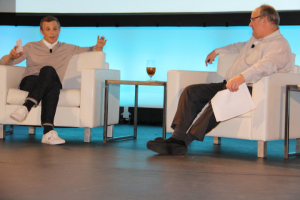
“The media division I run has two elements to it the GoPro original productions, and the User-Generated Content [UGC] community. The promise of UGC has out script the reality specially when it comes to a professional media organizations, but I think GoPro is uniquely situated to really take advantage of UGC. In 2014, 3.9 years of content was uploaded to YouTube with GoPro entangled, last year 2015, 4.9 years of content, that’s pretty amazing. The challenge from an organization [GoPro] standpoint, is finding that unicorn, how do we separate the we – from the channel. We want to bring people under our eco system who are at that level of production, so what we did and came up with last year was the GoPro Awards. We set aside 5 million dollars, basically to reward people for uploading to our eco system high end pr oductions. Since we launched it sometime Oct. or Sept. last year we’ve had some 81 thousand submissions, and have rewarded about 200 thousand dollars,” explained MacAdams. “We have an amazing eco system, we have this amazing natural system which a person goes out and buys a GoPro, they go out and shot this amazing video, they cuts it on our desktop software, they uploaded to us, we pay them for it, it comes into our eco system, we both use it as content on our platform and license it, through our premium content licensing portal, and that content becomes marketing and encourages other people to our buy GoPro and do the same.”
During the interview MacAdams, also revealed how the company deals with content creators, touched on Virtual Reality and the subject of drones.
“Some people are pure UGC, some we call curate UGC’s, and we have some correspondents, still working on the name, but they become contract [content creators] employees for GoPro,” added MacAdams, who also touched on a 16 camera Virtual Reality [VR] rig in partnership with Google, and a 6 camera super rig, and the GoPro Karma drone, yet to be released. “All I can say is that the drone will have more than camera.”
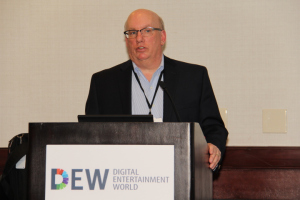
As the expo progressed many like me wanted to find out how the music business numbers looked. Is there really a future for the music business, what does it look like, and what do we need to get there ?, were three topics discussed during The Latest in Music Research, fireside chat also held Wed. – Feb. 10.
“When I started in music business the revenue of CD’s and digital downloads was around 14 billion, by 2005 it was down to 11 billion, and I estimate that when the numbers for 2015 come in it will be about 4 billion, we have shaved off about 10 billion off the [music] industry in the US alone,” explained Russ Crupnick, Managing Partner, MusicWatch. “The good news is if you start to add things like Streaming, Subscription fees, and Sound Exchange, things like that, we are starting to see those account for some meaningful dollars. I know there’s this big discussion of where does that money go, is not the same, at least for an artist — as it was selling a CD at Tower Records, I will admit to that, but from an industry perspective we are starting to see how streaming generates some real revenue. From a consumers perspective if you go back to 2000 and adjust those dollars to 2015, we used to spend about $112 dollars each, mostly on CD’s, if you take that number through 2015, two things have happened, first of all there’s probably half of the number music buyers in the United States there were back in 2000, and they are spending about half as much money, so when you think about the future at least when you take a look at these numbers, it doesn’t really look so bright until all those streaming numbers start to really kick-in and that’s probably going to take a few years. The one thing I would remind you is 97 percent of people are still engaging with music, it doesn’t necessarily have to be buying something, 97 percent are either streaming, some are still buying, they’re going to concerts, they’re engaging in some social way, the fact is we really haven’t lost our appetite for music, we’ve seen a change in the monetization. We are spending about 24 hours a week, or one day listening to music a week [on average].”
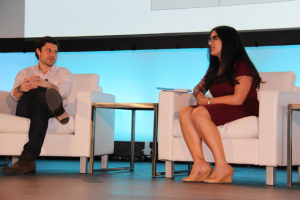
To end DEW Expo day two, Saba Hamedy, Digital Entertainment Reporter, Mashable, got Brett Bouttier, President, AwesomenessTV, to open up about the idea behind the company’s creation, Gen Z, and the company’s future.
“Were really just a media company to be simple about it, I don’t think we’ve so much ditched it [being referred to as an MCN ] as really letting it define us. The beginnings of AwesomenessTV started with this great idea that you can make great original programming in digital and put it together under a brand umbrella, that there would be an audience for that, and that audience specifically that we targeted is Gen Z and if you looked at the landscape in 2012 there was really no great brand for Gen Z, in the way that in the 80’s MTV defined sort of an entertainment brand for the 12 to 24 old demographics. There was just this giant white space and we can see all the activity and traffic and demand happening on YouTube, but it was everywhere and no one was really capitalizing on building a great channel brand. Our whole thesis was, build the brand by developing and producing and putting out really great content and we’ll build a media company that comes out of it, and one day [we] realized that there was this thing happening in that eco system that Multiple Channel Networks were sort of doing, which was to pull together lots of great different creators and give them, either help in figuring out their business or support promotionally, and we thought we’ll we need to do that for teens because this is the audience that is actually making content and they want to participate as much as they want to watch, so we created the MCN, and that became a great part of our business, it is just that a part of,” explained Bouttier. “We identified how popular the talent we were working with is with their audience, whether Awesomeness got behind something promotionally or whether an individual creator or star got behind something promotionally, we moved that audience around, direct them to somewhere to do something, whether they were on Vine and we dragged them to YouTube, or on YouTube and got them on Twitter, or they were musicians and they sold albums – which is great, it’s nothing new – that’s just the medium. …Digital is a real good place to develop franchises to develop content, to identify real great talent, both in front and behind the camera and then cultivate the franchise, pieces of content, or talent into programming that can live in every platform. We really [honestly] don’t discriminate, in terms of all the places our programming can live.”
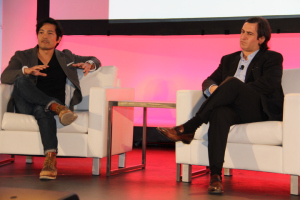
On Thur. – Fri. 11, the last day of the expo, Scott Greenberg, CEO & Co-Founder, Bento Box Entertainment [BBE], and Joel Kuwahara, co-founder, Executive Producer & Head of Technology, BBE, the producers of animated series such as Fox’s “Bordertown” and “Bob’s Burgers,” opened up to Dawn Chmielewski, Senior Editor, Politics & Tech. Policy, Re/code, about animation, their newly [created] partnership with virtual reality [VR] company Littlestar to create an exclusive VR animation channel, and the launch of Bento Box Digital Studios, which is developing a line of original content for digital and mobile consumption that will be available across a wide spectrum of outlets, from YouTube, Snapchat to video-on-demand services.
“The new division will allow Bento Box to work with creators to produce content for smaller, targeted audiences across borders, and often in niches that may not make sense for traditional broadcasters and cable providers,” added Greenberg. “We create content for the 18 to 34 years old demographic, but where are they consuming content now ?, A lot don’t have cable, they’re consuming online and on mobile. There’s enough opportunity [there] that we wanted to make it a whole business unit.”
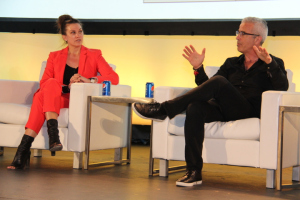
Another day three DEW expo highlight and one of the most anticipated keynotes was between Ken Hertz, Senior Partner, Hertz Lichtenstein & Young, LLP, who interviewed Kristin Patrick, Global Chief Marketing Officer, PepsiCo, about the importance of entertainment and music marketing, the brand and culture.
“For many years we’ve been involved in the entertainment industry and used music in particular as a platform for many of our brands and the reason we have done that is because there’s an emotional connection point to consumers. I think we were one of the first to sort of invent entertainment and music marketing and when I think back to the campaigns of the 80’s and 90’s, it was Britney Spears and Michael Jackson and Madonna. We’ve bolstered a lot of different songs by putting them in our spots and I think we really as a company have been known to create culture and not follow it, so it’s always been really [really] important to us to connect with trends just about their about to peak,” explained Patrick, while opening as she put it “a wonderful can of Pepsi,” she brought for Hertz. “I think that for many years packaged goods companies have relied on 30 second television spots to convey their message and as we all know, that is still an effective means of getting out to many people and casting a wide net, but were TiVo [ing] through commercials and we need to find new ways to connect with consumers and because our brands [I think] stand for so much more that just what’s in the can it or bag, it’s an opportunity for us to kind of unleash the equity and then participate in consumers lives in a way where we’re not pulling them towards us, they are seeking us out as a brand.”
The DEW Expo day three ended with the announcement of the DEW start-up of the year [award].
“Thank you all for coming this our biggest DEW event yet, we broke last year’s record by 450 attendees, so we were over 1800 attendees this year. As many of you know, this community of digital entertainment executives is still an evolving space, it’s not easy to really figure out who’s in the community and who’s not. The group that has been here all three days is just an incredible group of content creators, innovators, start-ups, tech companies, media companies, and this is the future,” eloquently explained Sherman. “There’s no reason why this group doesn’t start gelling together more and were committed to being the center piece for that year after year with DEW. I also wanted to give a big shot out to all the start-ups who came out and exhibited here, spent three days, I know what is like to be on a start-up budget, and for you guys to come out here, a lot of you flew here, brought exhibit tables, spent three days when you could be out fund raising or working on your product development to be here and that really means a lot to us. We hope this was a valuable event for you as well. For the last two years we’ve given out this award and the companies that have won this award have gone on to do great things. The first year’s winner Ninja Metrics closed their series b round this summer and Vendedy who was the winner last year has won probably ten awards since last year’s award, as people may know they are part of the Clinton Foundation [Global Initiative] and they’re a global company based out of New York and Dubai. This year’s crop of candidates and entries exceeded all our expectations, we had over 200 entries for the award, that was narrowed down to the 12 who came on the stage and presented today. We should give a big round of applause to that group. So this year’s award consist of a number of different pieces, first – Rackspace Startups is providing free hosting to everyone of the 12 finalist, you all have one year free hosting with Rackspace and for the winner they’ll have a premium hosting package valued at about 24 thousand dollars a year. The law firm Baker and Hostetler, has pledge 10 thousand of legal services and consultation at their office here, and IDG Ventures [USA] and Pat Kenealy who’s here, has pledged to also to do a two-hour consultation with senior partners Phil Sanderson and Pat up in San Francisco, really invaluable time you’ll have to spend with them, and my company Digital Media Wire has put up 15 thousand dollars of marketing services to the winner. We have quite a network to help you get your message out to the B2B audience and entertainment, media and technology. Who wants to know the winner ?, I am really pleased about who has won the award today because the individual and CEO of this company happened to be a speaker at our event a couple of years ago. At that time he was actually a media journalist and was working at Bloomberg, if you can’t figure out who that is by now, Jon come on up.”
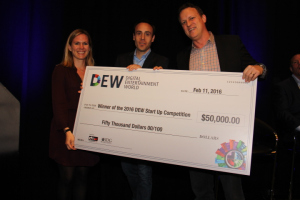
After the announcement, both Caroline Lesley and Jon Erlichman, co-founders, Parachute TV, joined Sherman on stage as he handed them the 50 thousand dollar equivalent check [prize] for the DEW start-up contest.
“Good afternoon everybody, thank you so much, this is so amazing. This is a wonderful event, thanks again to Ned. Parachute TV is a TV channel on Pariscope, we recognized early that live streaming was going to take off in a big way and we wanted to make the experience better, we were both big believers in live streaming and it’s growing at a rapid clip. We wanted to bring some sensibility and know how, we know how from the world of journalism and programming to make it an even better experience, so I am pretty blown away by this. It was just a great experience just to have the chance to present today, some great judges and we met some great start-ups founders as well. I don’t know what to say, this is exciting,” enthusiastically expressed Erlichman, before sitting down with Kevin Mayer, Senior Exec. VP & Chief Strategist Officer, The Walt Disney Company, and Mike Vorhaus, President, Magid Advisors, to hear how things are done at Disney.
With pens moving and questions being asked, The DEW expo eventually ended on a positive, engaging, and highly informative note, with anticipation already set very high and in motion for next year.
About Digital Entertainment World
Digital Entertainment World www.dewexpo.com is a unique event marketplace for global media and technology executives who want to evaluate the digital media landscape. This three-day event brings together leading industry executives from games, music, video, and publishing –the entire digital content ecosystem – who will take part in several keynotes, presentations and panel discussions tackling the industry’s key issues. At Digital Entertainment World (DEW), content creators and owners, enabling technology providers, digital distributors and device manufacturers will connect to create the infrastructure and technology partnerships necessary to monetize digital content. DEW is a joint venture between IDG World Expo and Digital Media Wire.

